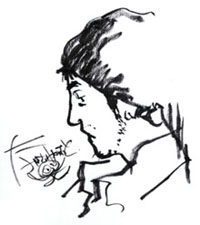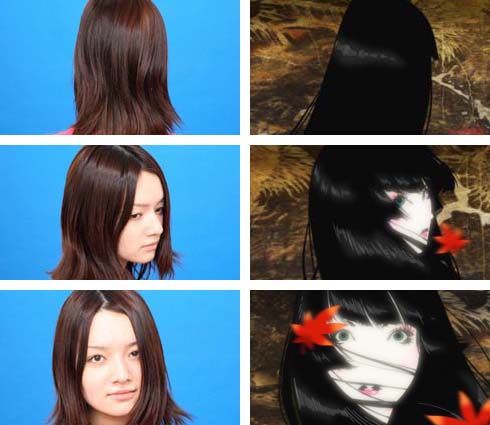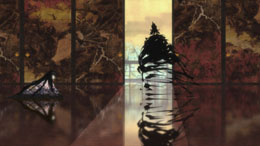The Making of Asience 5 part II: Kazuto Nakazawa (Director)
Kazuto Nakazawa did not just direct Asience: Hairy Tale. He was also responsible for character design, storyboards, animation directing and key art. The final result is a sixty-second concentrate of Nakazawa-esque themes and elements, and the film received great attention from international festivals throughout the globe. Nakazawa has been extensively involved with Production I.G's projects such as the animation segment in Kill Bill: Vol.1, the second opening sequence for the TV series Blood+, and the award-winning Kirin Lemon Black commercial. While focusing on Asience, we took this opportunity and asked Nakazawa the basics of creating anime by going over the works he directed in the past. This is the second of our exclusive 4-part interview with one of the most talented animators in the world scene.
 | Kazuto Nakazawa - Born in Niigata Prefecture on March 4, 1968. Animator. After graduating from the Tokyo Animator Gakuin, he joined studio Magic Bus, and later moved to studio Manglobe. His credits include Kill Bill: Vol. 1 (2003, animation sequence director), TV series Samurai Champloo (2004, character design, chief animation director), Linkin Park's video clip Breaking the Habit (2004 MTV VMA Viewer's Choice Award), the commercial film Kirin Lemon Black: Monster Blacks Fights Back (Best Commercial Film at the 11th Holland Animated Film Festival) and the episode Moondrive in Genius Party Beyond (2008). |
part II
Can you tell us something about character designs?
I came up with the designs straight away mostly. As for the Father, the client kept on saying, "make him look more like a sort Heian-style white-faced aristocrat." But how can you express anger with such a face? So I made it my way. As for the Princess, Hosono-san volunteered to pose for me. I felt pressured thinking she would be upset if I didn't draw her beautifully.
Do you mean you had a model for the Princess?
Yes, producer Mitsumoto-san recommended Momoyo Hosono. She is a production manager at I.G's Studio 9, and she is also a beautiful girl. For Cut 4 where the Princess turns around, and the last sequence where she circles as well as for some other poses, I did check with the real, I mean, her movements. I thought of using the tracing technique in the beginning, but that would make it too real, so I placed her photos on the side and copied her poses. The movements were mostly slow, so I thought it was easier to see the actual person moving. For instance, the way the princess shook her head somewhat awkwardly was beyond my imagination. By taking the picture, I think I've come up with far better results.

Talking about models, I heard you used Suzuki-san's eye for the Samurai.
Exactly. I told him all I wanted was to get a general idea of his eyes, and nothing more! (lol)
What are the highlights of this work?
I think the most intriguing thing about Asience is that these drawings are actually moving. I am surprised myself! (lol) At first, I thought it would be just fine with uneven movements because they might give some sort of ambience. You see, I like beautiful pictures, but I am not really interested in the pictures in motion. That's why Nishimura-san, the in-between checker, got mad at me. (lol) I really have to give them 120 out of 100 for the in-betweeners' work. They've done an excellent job.
Where was the most amazing part of all?
Everything, if you let me, but I think the cut where the Father disappears is the most fascinating one. When I was working with the storyboards, the concept in my mind was , "the Father disappears," but I drew a lot of key frames that it seemed almost impossible to insert in-betweens. I mean I had an impression that even without the in-betweens, the Father would disappear in animation. Anyway, they do have outrageously wonderful skills.
Another thing to mention is Kanta Kamei's work on compositing. I am impressed by his work every time. He is super. I can't go anywhere without him.

Was there any general concept for this work?
I would still say Japanese painting. In the past, there had been quite a few works based on the idea of using orthodox Japanese painting style in animation, so I was always discussing with Kamei-san about how we could use that idea with the latest animation technology. If we just moved the Japanese painting, the result would just be a moving Japanese painting. We started working without being sure how we could process it, and eventually all I hoped was to come up with a beautiful piece. I like Japanese paintings in the first place.
Then was this your long time wish to make this type of film?
Actually, my grandfather did Japanese paintings, so that's why I started drawing when I was about five.
In your directing works, you use animals and nature in a subtle way.
I've liked animals since I was a kid. It started with horses. I kept a bird and a dog in my house. As a boy, I didnt cry when someone died, but I cried when an animal died.
We often think designs of fighter jets are cool. That's not because the designers were after cool looking designs. They resulted from seeking better functions. Hawks, falcons and sparrows have the same sort of beauty. In that sense, I think I am a typical animism worshipper. I have more tendencies to adore nature and animals than other people.
Is that why you included a white falcon in Asience?
I always have a falcon flying in my heart. (lol) It's my eternal idol.
(5/2 - to be continued)
© 1994-2007 KAO CORPORATION. All Rights Reserved.

![WORK LIST[DETAILS]](/contents/works/design/images/left_title.gif)



 terms of use
terms of use